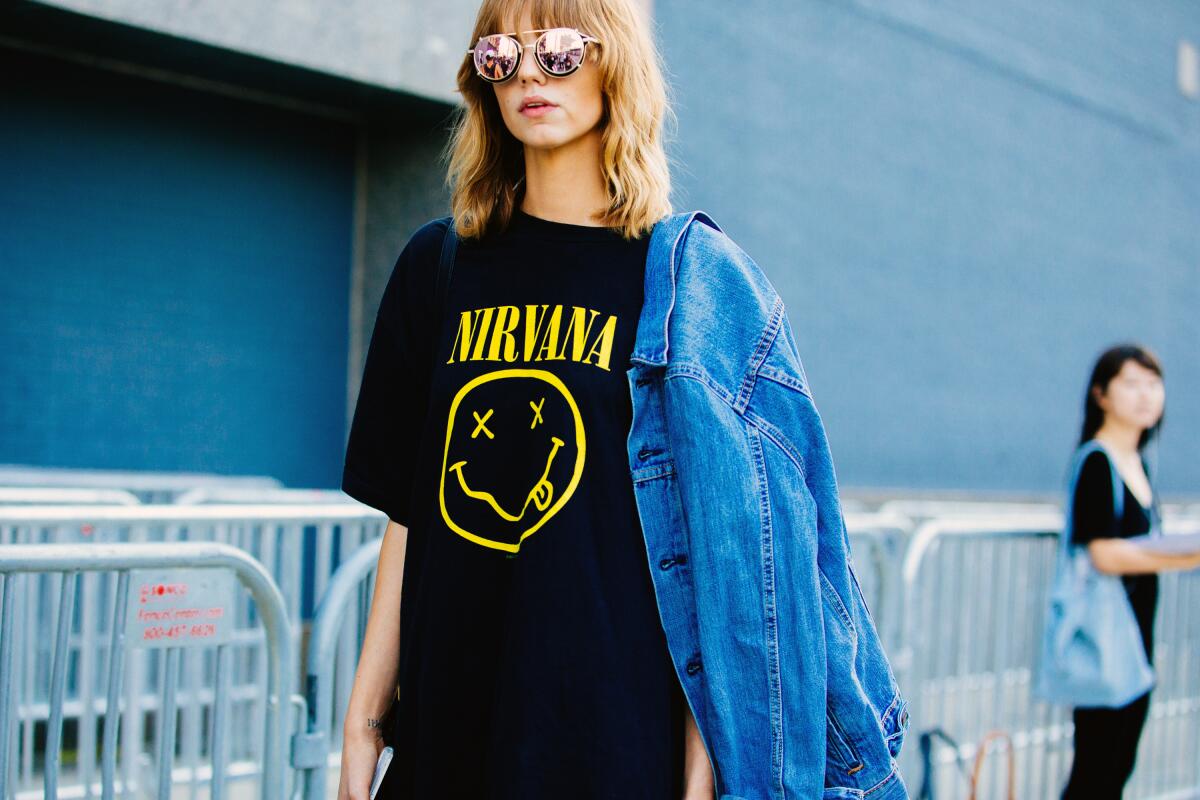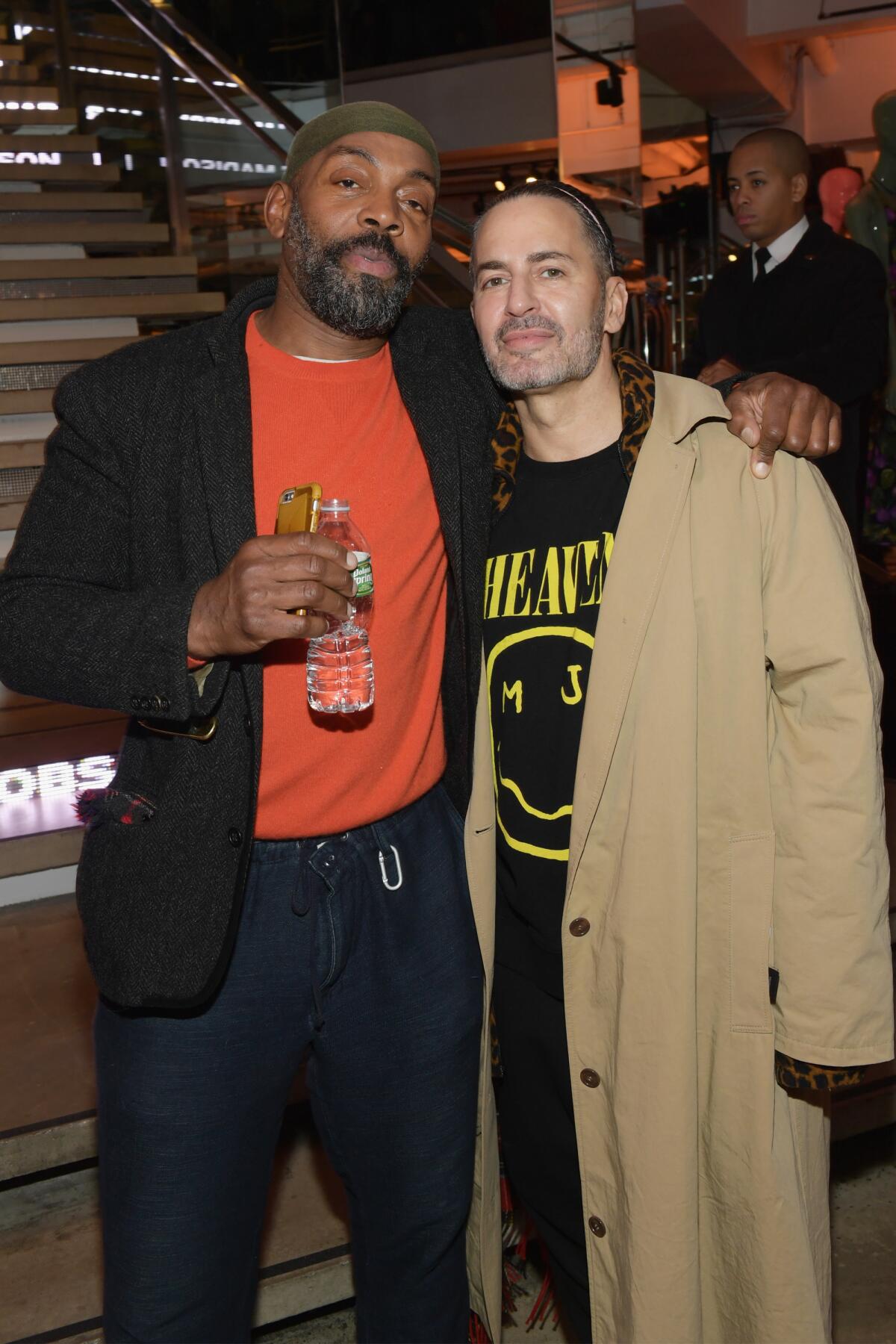Who created Nirvana’s famed smiley-face logo? A legal battle gets a new claimant

An ongoing legal battle between grunge icons Nirvana and fashion designer Marc Jacobs revolves around a blissed-out smiley face known to rock fans around the world — recognizable for its crooked grin, X’s for eyes and tongue hanging out.
The scraggly line drawing dates to Nirvana’s earliest days on Geffen Records subsidiary DGC, and has been a distinctive logo for the band ever since, appearing on nearly three decades’ worth of T-shirts, posters, key chains, hats, socks, coffee mugs, iPhone cases and now, in time for our pandemic, face masks.
A lawsuit filed in December 2018 in federal court by Nirvana LLC followed the “intentional copy” of the smiley (with minor alterations) by Marc Jacobs International on clothing in a collection called Bootleg Redux Grunge. Lawyers for the band declared full ownership of the image, noting that it was “created by Kurt Cobain in about 1991 and registered for copyright in 1993.”
The only problem, according to former Geffen Records art director Robert Fisher, who designed the covers to most of Nirvana’s releases since 1991 (including the 2015 box set “Montage of Heck”), is that the late bandleader Cobain didn’t create the smiley. Fisher says he did.
Family and collaborators discuss the making of Tom Petty’s 1994 solo album ‘Wildflowers,’ which is being reissued as a box set with dozens of unreleased tracks.
Last week, Fisher filed a motion in federal court to intervene in the case in order to claim both authorship and ownership of the smiley face, which he says was originally created as a favor to Nirvana’s management in 1991. Although his first priority is that he be credited as creator, his larger argument is that since it was not done as part of his job at Geffen, and he was not employed by the band or its managers, he is the rightful owner of the copyright.
Fisher says he has no intention of seeking payment for 29 years of past use of the smiley by Nirvana, but may seek compensation going forward. His motion will be ruled on in the coming months.
“Since I drew it, I want to be known as the guy that drew it. It’s as simple as that,” Fisher, 58, said in an interview at his home in Woodland Hills. “I don’t think it’s fair that they try and take out a copyright and say Kurt did it.”
Nirvana LLC attorney Bert H. Deixler called Fisher’s assertion “factually and legally baseless,” in a brief email exchange, and said it will be “vigorously” challenged. He added that it’s also unlikely to change the direction of the band’s case against Jacobs. “We are marching forward,” Deixler wrote. “The copying Marc Jacobs undertook for his financial benefit is very far from protectable under any theory.”
Nirvana LLC was a partnership formed in 1997 to manage the band’s affairs following Cobain’s death, giving equal representation to surviving band members Krist Novoselic and Dave Grohl and the Cobain estate (represented by the singer’s widow, Courtney Love, and, later, their daughter, Frances Bean Cobain). The lawsuit against Jacobs will go to trial in 2021, following many COVID-19-related delays.
The Bootleg Redux Grunge collection included shirts and sweaters that mirrored a well-known band design — but with the Nirvana name replaced in similar size and font with “HEAVEN,” and the smiley face’s X-eyes swiped out with the designer’s own initials: “M” and “J.” Jacobs also used his altered version of the smiley for promotion at events and in stores.

The fashion label’s Grunge line continues, but the smiley face products are currently sold out or no longer available, though prices are still listed online as high as $115 for the T-shirt, or higher for a sweatshirt with the same design. (Also named in the suit filed in the U.S. District Court for the Central District of California were the stores Saks and Neiman Marcus, which sold the smiley face products in the U.S.)
The financial stakes for Nirvana vs. Marc Jacobs could be significant. Nirvana seeks “compensatory and punitive damages” from the fashion label, “in an amount to be determined at trial.” The band’s music and merchandise continue to earn in the millions every year.
In its short career before the 1994 death of Cobain, Nirvana created a body of work that reached a rarefied status that matched multi-platinum sales with lasting cultural impact. Most recently, the mournful ballad “Something in the Way” charted in August after appearing in a trailer for the upcoming film “The Batman,” and its landmark 1991 album, “Nevermind,” just marked its 490th week on the Billboard Top 200 chart.
Fisher says he was unaware of the lawsuit until he was alerted last November by a Nirvana fan who was outraged that the fashion company was using the band’s smiley face and T-shirt design. According to Fisher, he immediately contacted Nirvana’s management and offered to help, then quickly followed up with an email that included evidence of the smiley’s genesis that he still had stored in his garage.
Fisher says he was soon instructed not to send any more emails, and eventually learned that Nirvana had copyrighted the smiley image and T-shirt design decades earlier. Fisher says he was surprised by the revelation, though obviously aware that the happy face continued to be marketed, never thinking much about compensation.
“It’s on everything: yoga pants, sunglasses, air fresheners. They’re still selling a billion T-shirts,” said Fisher, whose wife bought a Nirvana smiley shirt for their son at Target a couple of years ago. “I’d see them around over the years. ‘Hey, there’s my shirt. Cool!’ And then I’m like, ‘Man, if I only had a nickel for every one of those sold,’ and kind of joke and go, ‘Whatever.’”
“I think its the best song EVER, in the WORLD, EVER!!!” Nandi Bushell, 10, said of her new theme song penned by Foo Fighters frontman Dave Grohl.
Discussions online about the drawing among fans (and in news articles) often take at face value the idea that it was created by Cobain, though physical evidence or published comments from the singer about the logo have yet to emerge. One theory is that it was inspired by a similar smiley on the marquee of the defunct Lusty Lady Strip Club in Seattle. Fisher insists none of that is true.
He says the smiley was created after getting a call from Nirvana’s management requesting a new T-shirt design for an upcoming tour. He was provided some typically ironic, nonsensical text for the shirt back: “Flower Sniffing, Kitty Pettin, Baby Kissing, Corporate Rock Whores.” And for the front, he was asked to create an image in the same general size and shape as Nirvana’s previous tour T-shirt that depicted the Circles of Hell from Dante’s “Inferno.”
The original image, he explained, was created with a technique he learned while a student at Otis/Parsons School of Design: He first drew the image at about the size of a quarter on tracing paper, then enlarged it with a photocopier, resulting in raw, uneven lines. (He’d also used a photocopier to create the wavy underwater effects on the word “Nevermind” for that album’s cover.)
Soon after the T-shirt creation, the smiley was put on a flyer inviting fans to participate as extras in the “Smells Like Teen Spirit” video shoot, which was handed out to fans at a Nirvana performance at the Roxy. It appeared again on an invitation to a record release party in Seattle.
“I just started putting it on stuff for Nirvana,” said Fisher. “People were like, ‘Oh, that’s pretty cool,’ so I just kept using it.”
In depositions, Grohl and Novoselic said they did not know who designed the smiley, according to a November filing by Jacobs. Nirvana LLC has since filed a declaration that all parties within the band’s company agree that it was created by Cobain.
“This has very little to do with Nirvana the band,” said Fisher’s attorney, Inge De Bruyn. “This is just about two corporate structures making millions off a design that neither one of them created or paid for.”
At Geffen, Fisher received a salary, and no financial windfall if one of his designs ended up on an album that sold millions.
At the same time, it was common for Geffen staffers to do additional work for bands outside of their label duties. Fisher noted that when another Geffen act, Aerosmith, asked Fisher to work up some logo ideas, the band paid him $500.
“At Geffen, all the art directors were hustling. We would take on extra jobs,” Fisher said. “I worked on movie posters and CD soundtracks for other labels. And Geffen was totally cool about letting people stay later or come in on the weekend and use the computers.”
Just as often, he says, band managers would request help designing stickers, tour laminates and other pieces for Geffen acts. He did it for Nirvana, Beck and many others without any talk of compensation, though it was considered outside label duties.
He saw the additional tasks as a way to support the acts he worked with, and as an extension of the original DIY punk ethos — where photographers might shoot free pictures for a young band and fans provided floors to sleep on for groups traveling cross-country on low-budget van tours.
“Whenever I work with a band, I’m their biggest fan,” Fisher said. “I’d do whatever it takes.”
Illustrator Rodger Ferris, who created artwork for Geffen as a freelancer in the early ‘90s, corroborates Fisher’s claim about the smiley face. Ferris made small line drawings for the back covers of Nirvana’s “In Utero” and “Unplugged in New York,” but his first work for the band was on a postcard promoting their Jan. 11, 1992, appearance on “Saturday Night Live.”
His illustration on the card included a woman dancing in a T-shirt with the smiley face. Ferris said his reference for the smiley was an early photocopy of the image that Fisher had on his office wall.
“I was looking at his artwork that was on his wall when I was painting that in,” said Ferris, who often completed his work in the art director’s office. He added that it was understood even then that Fisher had created it. “I wasn’t there when he did it, but it was always his. It wasn’t a question.”
Fisher, who once enjoyed collaborating directly with band members when Nirvana was still an active trio, is not convinced that Grohl and Novoselic are personally aware of his unexpected role in the case or what he sees as his rightful credit for creating the popular smiley face drawing.
“I’d like to think if they found out about it, they’d be like, ‘Oh, wait a minute,’” said Fisher. “Having to deal with ‘Nirvana Inc.’ is a whole different ball of wax than just dealing with Krist, Kurt and Dave.”
More to Read
The biggest entertainment stories
Get our big stories about Hollywood, film, television, music, arts, culture and more right in your inbox as soon as they publish.
You may occasionally receive promotional content from the Los Angeles Times.










